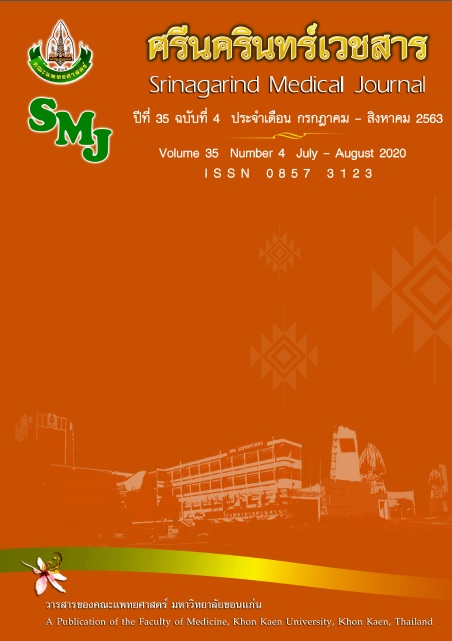Responsiveness of Lumbar Lordosis Angle and Other Biomechanical Parameters in Individuals with Lumbar Hyperlordosis: An Experimental Study
Abstract
การตอบสนองของมุมการแอ่นของกระดูกสันหลังส่วนเอวและตัวแปรอื่นทางชีวกลศาสตร์
ในผู้ที่มีภาวะกระดูกสันหลังส่วนเอวแอ่นมากกว่าปกติ: การศึกษาเชิงทดลอง
ธนัชพร จรรยาฐิติภัทร*, ประเสริฐ สกุลศรีประเสริฐ, พีร์มงคล วัฒนานนท์, พูนสุข กันทา
คณะกายภาพบำบัด มหาวิทยาลัยมหิดล นครปฐม ประเทศไทย
หลักการและวัตถุประสงค์: การตรวจประเมินและการจัดการในผู้ที่มีภาวะกระดูกสันหลังส่วนเอวแอ่นมากกว่าปกติมีความสำคัญเพื่อป้องกันปัญหาทางกระดูกและกล้ามเนื้อในอนาคต การตอบสนองของตัวแปรจึงมีความสำคัญที่ควรทำการศึกษาเนื่องจากเป็นสิ่งที่แสดงความสามารถของแต่ละตัวแปรในการบ่งชี้การเปลี่ยนแปลงที่เกิดขึ้นต่างช่วงเวลาได้ ซึ่งยังไม่มีการศึกษาในปัจจุบัน วัตถุประสงค์ของงานวิจัยนี้ เพื่อดูการตอบสนองของตัวแปรทางชีวกลศาสตร์ในผู้ที่มีภาวะกระดูกสันหลังส่วนเอวแอ่นมากกว่าปกติ
วิธีการ: ผู้ที่มีกระดูกสันหลังส่วนเอวแอ่นมากกว่าปกติทั้งหมด 15 ราย มีอายุระหว่าง 20 ถึง 30 ปีได้รับการเชิญชวนเข้าทำการศึกษา ตัวแปรที่ใช้ในการประเมิน คือ องศาการแอ่นของกระดูกสันหลังส่วนเอว องศาการงอสะโพก องศาการกางสะโพก องศาการงอเข่า และร้อยละการหดตัวสูงสุดของ transversus abdominis/internal abdominal oblique, rectus abdominis, external abdominal oblique, lumbar erector spinae และ multifidus ผู้เข้าร่วมวิจัยจะได้รับการประเมิน 2 ครั้ง: ก่อนและหลังยืดกล้ามเนื้องอสะโพก
ผลการศึกษา: ค่าการเปลี่ยนแปลง ขนาดของผล และ standardized response mean (SRM)ได้รับการคำนวณเพื่อแสดงถึงค่าการตอบสนอง การศึกษานี้พบว่าตัวแปรที่มีการตอบสนองต่อการเปลี่ยนแปลงสูงสุดคือ องศาการแอ่นของกระดูกสันหลังส่วนเอว (ALL) โดยมีค่า standardized response mean (SRM) คือ 1.61 ขณะที่ตัวแปรอื่นมีการตอบสนองเพียงเล็กน้อย
สรุป: งานวิจัยนี้สนับสนุนว่า องศาการแอ่นของกระดูกสันหลังส่วนเอว เป็นตัวแปรที่ตอบสนองต่อการเปลี่ยนแปลงสูงสุดในผู้ที่มีภาวะกระดูกสันหลังส่วนเอวแอ่นมากกว่าปกติภายหลังการรักษาเพื่อลดองศาการแอ่นของกระดูกสันหลังส่วนเอว
คำสำคัญ: คลื่นไฟฟ้ากล้ามเนื้อ; ขนาดของผล; ค่าการเปลี่ยนแปลง; กระดูกสันหลังส่วนเอว; ความไว
Background and Objective: The assessment and management in individuals with lumbar hyperlordosis are important to prevent further musculoskeletal disorders. The responsiveness is necessary to be studied because it represents the ability of each parameter to indicate the change overtime, which awaits formal investigation. This study aimed to investigate the responsiveness of biomechanical parameters in individuals with lumbar hyperlordosis.
Methods: Fifteen individuals with lumbar hyperlordosis, aged 20 to 30 years, were recruited.
The parameters measurement were angle of lumbar lordosis (ALL), degree of hip flexion, degree of hip abduction, degree of knee flexion, and percent maximum voluntary isometric contraction (%MVIC) of transversus abdominis/internal abdominal oblique (TrA/IO), rectus abdominis (RA), external abdominal oblique (EO), lumbar erector spine (LES), and multifidus (MF). They were assessed 2 times: before and after iliopsoas stretching.
Results: Change score, effect size, and standardized response mean (SRM) were calculated to represent the responsiveness of each parameter. The findings showed that the most responsive parameter was ALL, SRM of 1.61, while, the other parameters had lower responsiveness.
Conclusion: This study supported that ALL was the most responsive parameter to detect the change in individuals with lumbar hyperlordosis after the intervention aiming for decreasing lumbar lordosis.
Keywords: EMG; effect size; change score; lumbar spine; sensitivity


